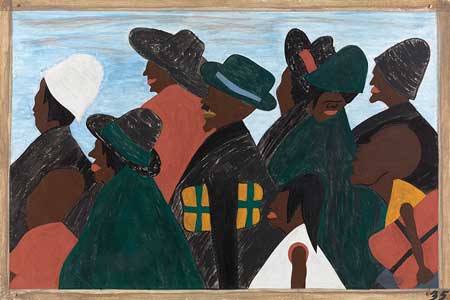Performance, Dance, Concert
Directed by Jakari Sherman
Founder and Executive Director: C. Brian Williams
Step Afrika!
ArtsEmerson
Emerson Cutler Majestic Theatre
May 3-6, 2018
Special Guests: Kofi Agyei, Lionel B. Lyles II
With Mfoniso Akpan, Dionne Eleby, Kara Jenelle, Conrad Kelly, Joe Murchison, Ronniique Murray, Anesia Sandifer, Jakari Sherman, Brittny Smith, Jordan Spry, Jabari Jones, Ta’quez Whitted

“They left the South in great numbers. They arrived in the North in great numbers.” (1940-1941)
Image: Courtesy of the Philips Collection, Washington D.C.
As a very young artist, Jacob Lawrence (1917-2000) created a series of sixty panels to trace and evoke the drama of the great African-American migration from South to North in the early decades of the twentieth century. Painted simply in tempera, and mostly on hardboard, the works collectively call forth the epic sense of that social drama. In residence at the Philips Collection in Washington, D.C., the series had major showings in 1995 and 2015 at the Museum of Modern Art in New York City which with the Philips co-owns the works.
Step Afrika, a group that has been around for over twenty years, got its starting inspiration from the tradition of stepping, a dance motif which became popular in African-American fraternities and sororities. Its movements and sounds derive from a combination of sources and bears at once an eclectic feel and a totally unique spirit. Percussive, gymnastic and enthusiastically expressive, the style easily bends and folds into a variety of other dance motifs.
For a long time, Step Afrika simply offered its varieties of demonstrations and performances without any narrative inspiration; the current show is the first one to take a narrative – Lawrence’s Migration series – and create a series of dances to honor it. The result is moving, dynamic inventive and entirely rousing.
During the performance, a changing series of projections taken from Lawrence’s Migration series are displayed. At certain points the images are reproduced dramatically on stage; at other points, the spirit of them is called forth.
The first half of the program features the performers in turn of the century dress, calling forth decades when African-Americans had recently been liberated and began to find their ways out of Southern plantations. Stepping provides the primary dance style here. With its varied movements and sounds of stomping and slapping, it creates a vivid sense of varied aspects of African culture which survived in the African-American South. A series inspired by the early twentieth-century spiritual Wade In The Water movingly caps this first half. Overall, the results are exquisite.
The second half focuses on the jazz age, with the cast arrayed in a new set of outfits and moving with sashays and bends of a totally different order. Whereas a unique solo tribal drummer had carried the spirit of the first half, a solo saxophone carries the spirit in the second, the first major piece of which, entitled Trane Suite, calls forth the movement of African-Americans towards urban centers in the north via railroad. The final piece, Chicago, completes that image, depicting the new metropolitan life for the almost half-million African-Americans who moved to Northern cities between 1910 and 1920.
At different points in the performance the entire cast gets into the drumming act, but particularly notably so in the first piece, Drum Call. Incredibly syncopated and varied rhythmically, the entire cast drums, swings arms, slaps and gestures in ways that set the energetic tone for the entire performance.
In the highly informative talkback after the show, members of the cast, director Jakari Sherman, and artistic director C. Brian Williams, made the point, also noted in the program, that stepping, with its foot stomping and hand slapping of boots, arose when drumming became a threat to the early white masters of the enslaved African-American population. Through the dastardly Negro Act of 1740, they outlawed the right of African-Americans to assemble, read or write, or to use their drums. Consequently, variations of what later became stepping were developed as rhythmic and musical alternatives to drumbeats.
Curiously the talkback revealed the great variety in academic background among members of the company, many of whom did not start out as professional dancers but got directed to Step Afrika through their collegiate stepping experiences. It’s a charming historic side-note, given the high degree of professionalism in the performance.
Overall: the array of dances and rhythms put forth by the company is astonishing; in support of its Jacob Lawrence narrative it becomes moving as well as exuberant.
– BADMan
Leave a Reply